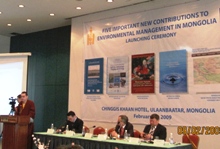Mongolia: Buddhists
The following information has been extracted from the
Mongolian Buddhists Protecting Nature Handbook which can be downloaded in English and in Mongolian.
Since 1990, Mongolia has seen a massive increase in the number of groups working
in the environmental sector. There are groups helping to reduce pollution, address
deforestation, bring in eco-tourism, save species and achieve many other things.
However, surprisingly few of them have established direct relationships with one of
the most historical, sizeable, and influential sectors of Mongolian society: the Buddhist
sangha. ARC, in collaboration with Gandan Monastery and the World Bank’s NEMO fund in Mongolia has created a new
handbook in an attempt to address this.
The handbook can be downloaded here, in full, in English
here and in Mongolian
here.
It is the first comprehensive guide to approaching and working with Buddhist
communities in Mongolia, and it explains why this is an area of action and outreach
which could, and should, be explored by environmental groups from both within and
outside Mongolia.
 |
 |
 |
Launch of the handbook in UB in February 2009 |
It is in four sections. The first is full of stories and examples, and is an exploration of
just why the Buddhist monasteries and organisations have such potential to achieve
so much within the environmental movement – through their own beliefs, teachings
and structures – and an outline of the potential of these communities for future
environmental work. It gives an idea of some of the
ancient Buddhist wisdom on taking care of nature and it also provides a practical and useful guide to how to make
contact with the
sangha
in Mongolia, and what the correct etiquette is during meetings
and temple visits.
The second part includes a number of
case studies from around Mongolia, of Buddhist
monasteries that have already made sizeable steps to increase their environmental
activism, and improve the natural environment around their communities. These include stories of monks helping people in mining areas deal with - and take steps to prevent - pollution, as well as tree-planting programmes, and a monastery-led project to protect the huge Mongolian salmon called the taimen.
The third part is much more list-based. It also includes details of some of the major
monasteries, as well as the major secular environmental organisations operating in
Mongolia, with contact details, a glossary, and a more detailed outline of Buddhism
in Mongolia for those who are interested.
And the fourth consists of the Mongolian Buddhist Eight Year Plan, which can be downloaded here.
“We need to live as the Buddha taught us to live, in peace and harmony with
nature, but this must start with ourselves. If we are going to save this planet
we need to seek a new ecological order, to look at the life we lead and then
work together for the benefit of all; unless we work together no solution can be
found. By moving away from self-centeredness, sharing wealth more, being more
responsible for ourselves, and agreeing to live more simply, we can help decrease
much of the suffering in the world,” from the Buddhist Statement on Ecology 1996.
The full brochure can be downloaded in
English, or in
Mongolian. In addition there is an
A3 poster of a new thangka about Buddhists protecting Nature.
Pages about Mongolian Environmental Wisdom, taken from the Handbook.
The Mongolian Lord of Nature.
Sacred texts, places and ovoos.
Sacred sites
in Mongolia.
Traditional Environmental Law in Mongolia.
The work that the monks, in conjunction with ARC and the World Bank and others, are carrying out to rediscover the sutras about sacred land in Mongolia.
Do you want to support this?
For full contact and address details of Mongolian Buddhist Monasteries, please see page 57 of the
Handbook. And for details of local Development, Environmental and Educational NGOs, please visit pages 58-59 of the
Handbook.
Other links to Mongolian Buddhism and the Environment
Link here to access the news story about the launch of the Mongolian Buddhist Handbook.
Link
here to download the Mongolian Buddhist Handbook in English. (Please note this file is 1.15MB)
Link
here to download the Mongolian version of the Handbook.(A 2MB file.)
Link here to download the guide to the Mongolian Buddhists’ Eight Year Plan (this file is 4.13MB).
Link to Mongolian Case Studies.
And
here on how to make contact with the Sangha.
To download the A3 poster of a new thangka about Buddhists protecting Nature, link
here (5.61MB).
Brief History of Mongolian Buddhism.
Buddhism and the Environment.
Women in Buddhism in Mongolia.
Key Figures in Mongolian Buddhism.
Key Meetings in Mongolia.
Mongolian Buddhists and Development.
Mongolian Buddhists and Ecology.
Mongolian Buddhist Hunting Ban.
The Lost Sutras.
|

